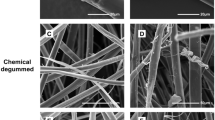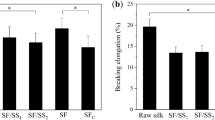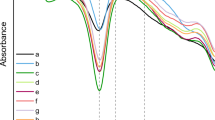Abstract
Silk sericin (SS) is a natural polymer widely studied in the design of biodegradable materials for cosmetic, biomedical, food, and chemical applications. This work was designed to explore the molecular and structural characteristics of SS extracted from different silk sources with different processing degrees: high-quality cocoons (NCs), defective cocoons (DCs), and raw silk yarn (Y). The last two sources have been less studied. SS solutions were obtained from each source using the high-temperature and high-pressure degumming method (HTHP). The molecular weight distribution and amino acid composition of SS extracts were determined using gel permeation chromatography (GPC) and reversed-phase chromatography (RP HPLC), respectively. SS films were formed from each solution and then characterized by attenuated total reflectance Fourier transform infrared spectroscopy (ATR-FTIR), nuclear magnetic resonance spectroscopy (NMR), and differential scanning calorimetry (DSC). Water uptake and degradation of SS films were also evaluated. The molecular characteristics of SS extracts were related to the processing degree of the silk source. Moreover, the properties of SS films seemed to be dominated by the primary structure and the presence of natural impurities in each extract. The results suggest that silk sources could be selected ad hoc to design SS materials with distinctive properties for specific applications.
This is a preview of subscription content, access via your institution
Access options
Subscribe to this journal
Receive 12 print issues and online access
$259.00 per year
only $21.58 per issue
Buy this article
- Purchase on Springer Link
- Instant access to full article PDF
Prices may be subject to local taxes which are calculated during checkout






Similar content being viewed by others
References
Mondal M, Trivedy K, Kumar SN. The silk proteins, sericin and fibroin in silkworm, Bombyx mori Linn., - a review. Casp J Env Sci. 2007;5:63–76.
Veiga A, Castro F, Rocha F, Oliveira AL. Recent Advances in Silk Sericin/Calcium Phosphate Biomaterials. Front Mater. 2020;7. https://doi.org/10.3389/fmats.2020.00024.
Gupta D, Agrawal A, Chaudhary H, Gulrajani M, Gupta C. Cleaner process for extraction of sericin using infrared. J Clean Prod. 2013;52:488–94. https://doi.org/10.1016/J.JCLEPRO.2013.03.016
Dash BC, Mandal BB, Kundu SC. Silk gland sericin protein membranes: fabrication and characterization for potential biotechnological applications. J Biotechnol. 2009;144:321–9. https://doi.org/10.1016/j.jbiotec.2009.09.019
da Silva TL, da Silva AC, Vieira MGA, Gimenes ML, da Silva MGC. Biosorption study of copper and zinc by particles produced from silk sericin – alginate blend: evaluation of blend proportion and thermal cross-linking process in particles production. J Clean Prod. 2016;137:1470–8. https://doi.org/10.1016/j.jclepro.2015.05.067
Ahsan F, Ansari T, Usmani S, Bagga P. An insight on silk protein sericin: from processing to biomedical application. Drug Res (Stuttg). 2018;68:317–27. https://doi.org/10.1055/s-0043-121464
Kunz RI, Brancalhão RMC, Ribeiro LDFC, Natali MRM. Silkworm sericin: properties and biomedical applications. Biomed Res Int. 2016;2016:1–19. https://doi.org/10.1155/2016/8175701
Akai H. The structure and ultrastructure of the silk gland. Experientia. 1983;39:443–9. https://doi.org/10.1007/BF01965158
Shaw JTB, Smith SG. Amino-acids of Silk Sericin. Nature. 1951;168:745–745. https://doi.org/10.1038/168745a0
Mercer EH, Meyer FH. The X-Ray Pattern of Sericin and Silk Wax from Bombyx mori. Text Res J. 1953;23:243–6. https://doi.org/10.1177/004051755302300404
Komatsu K. Studies on dissolution behaviors and structural characteristics of silk sericin. Bull Seric Exp Stn. 1975;26:135–256.
Sothornvit R, Chollakup R, Suwanruji P. Extracted sericin from silk waste for film formation. Songklanakarin J Sci Technol. 2010;32:17–22.
Gupta D, Agrawal A, Rangi A. Extraction and characterization of silk sericin. Indian J Fibre Text Res. 2014;39:364–72.
Lee YW. Silk Reeling and Testing Manual. Rome: Food and Agriculture Organization of the United Nations; 1999.
Babu KM. Natural textile fibres: animal and silk fibres. In: Rose Sinclair, editor. Textiles and Fashion, Sawston: Woodhead Publishing; 2015. p. 57–78. https://doi.org/10.1016/B978-1-84569-931-4.00003-9.
Wu MH, Yue JX, Zhang YQ. Ultrafiltration recovery of sericin from the alkaline waste of silk floss processing and controlled enzymatic hydrolysis. J Clean Prod. 2014;76:154–60. https://doi.org/10.1016/j.jclepro.2014.03.068
Barajas-Gamboa JA, Alvarez-López C, Restrepo Osorio A, Serpa-Guerra AM. Sericin applications: a globular silk protein. Ing y Compet. 2016;18:93–103.
Li D, Amoah PK, Chen B, Xue C, Hu X, Gao K, et al. Feasibility of Growing Chlorella sorokiniana on Cooking Cocoon Wastewater for Biomass Production and Nutrient Removal. Appl Biochem Biotechnol. 2019;188:663–76. https://doi.org/10.1007/s12010-018-02942-7
Li H, Shi W, Wang W, Zhu H. The extraction of sericin protein from silk reeling wastewater by hollow fiber nanofiltration membrane integrated process. Sep Purif Technol. 2015;146:342–50. https://doi.org/10.1016/j.seppur.2015.04.004
Wang R, Zhu Y, Shi Z, Jiang W, Liu X, Ni QQ. Degumming of raw silk via steam treatment. J Clean Prod. 2018;203:492–7. https://doi.org/10.1016/j.jclepro.2018.08.286
Ghosh S, Rao RS, Nambiar KS, Haragannavar VC, Augustine D, Sowmya SV. Sericin, a dietary additive: Mini review. J Med Radio Pathol Surg. 2019;6:4–8. https://doi.org/10.15713/ins.jmrps.153
Gulrajani ML, Purwar R, Prasad RK, Joshi M. Studies on structural and functional properties of sericin recovered from silk degumming liquor by membrane technology. J Appl Polym Sci. 2009;113:2796–804. https://doi.org/10.1002/app.29925
Arango MC, Montoya Y, Peresin MS, Bustamante J, Álvarez-López C. Silk sericin as a biomaterial for tissue engineering: a review. Int J Polym Mater Polym Biomater. 2020;2020:1–15. https://doi.org/10.1080/00914037.2020.1785454
Castrillón Martínez DC, Zuluaga CL, Restrepo-Osorio A, Álvarez-López C. Characterization of sericin obtained from cocoons and silk yarns. Procedia Eng. 2017;200:377–83. https://doi.org/10.1016/j.proeng.2017.07.053
Arteaga YA, Llanos GAH, Martínez DC, Aristizábal MC, Gamboa JAB, López CÁ. Properties of colombian silk sericine. Rev Lasallista Investig. 2018;15:57–66. https://doi.org/10.22507/rli.v15n1a5
Arango MC, Álvarez-López C. Effect of freezing temperature on the properties of lyophilized silk sericin scaffold. Mater Res Exp. 2019;6. https://doi.org/10.1088/2053-1591/ab3594.
Wu L, Liu M. Preparation and properties of chitosan-coated NPK compound fertilizer with controlled-release and water-retention. Carbohydr Polym. 2008;72:240–7. https://doi.org/10.1016/j.carbpol.2007.08.020
Capar G, Aygun SS, Gecit MR. Separation of sericin from fatty acids towards its recovery from silk degumming wastewaters. J Memb Sci. 2009;342:179–89. https://doi.org/10.1016/j.memsci.2009.06.039
Wray LS, Hu X, Gallego J, Georgakoudi I, Omenetto FG, Schmidt D, et al. Effect of processing on silk-based biomaterials: reproducibility and biocompatibility. J Biomed Mater Res Part B Appl Biomater. 2011;99B:89–101. https://doi.org/10.1002/jbm.b.31875
Cozza N, Bonani W, Motta A, Migliaresi C. Evaluation of alternative sources of collagen fractions from Loligo vulgaris squid mantle. Int J Biol Macromol. 2016;87:504–13. https://doi.org/10.1016/j.ijbiomac.2016.03.013
Bucciarelli A, Chiera S, Quaranta A, Yadavalli VK, Motta A, Maniglio D. A Thermal-Reflow-Based Low-Temperature, High-Pressure Sintering of Lyophilized Silk Fibroin for the Fast Fabrication of Biosubstrates. Adv Funct Mater. 2019;29:1–13. https://doi.org/10.1002/adfm.201901134
Jaramillo‐Quiceno N, Restrepo‐Osorio A. Water‐annealing treatment for edible silk fibroin coatings from fibrous waste. J Appl Polym Sci. 2020;137:48505 https://doi.org/10.1002/app.48505
Callone E, Dirè S, Hu X, Motta A. Processing Influence on Molecular Assembling and Structural Conformations in Silk Fibroin: elucidation by Solid-State NMR. ACS Biomater Sci Eng. 2016;2:758–67. https://doi.org/10.1021/acsbiomaterials.5b00507
Teramoto H, Kakazu A, Yamauchi K, Asakura T. Role of Hydroxyl Side Chains in Bombyx mori Silk Sericin in Stabilizing Its Solid Structure. Macromolecules. 2007;40:1562–9. https://doi.org/10.1021/ma062604e
Yamdej R, Pangza K, Srichana T, Aramwit P. Superior physicochemical and biological properties of poly(vinyl alcohol)/sericin hydrogels fabricated by a non-toxic gamma-irradiation technique. J Bioact Compat Polym. 2017;32:32–44. https://doi.org/10.1177/0883911516653145
Puerta M, Peresin MS, Restrepo-Osorio A. Effects of Chemical Post-treatments on Structural and Physicochemical Properties of Silk Fibroin Films Obtained From Silk Fibrous Waste. Front Bioeng Biotechnol. 2020;8:1–11. https://doi.org/10.3389/fbioe.2020.523949
Wang YJ, Zhag YQ. Three-layered sericins around the silk fibroin fiber from Bombyx mori cocoon and their amino acid composition. Adv Mater Res. 2011;175–176:158–63.
Tamada Y, Sano M, Niwa K, Imai T, Yoshino G. Sulfation of silk sericin and anticoagulant activity of sulfated sericin. J Biomater Sci Polym Ed. 2004;15:971–80. https://doi.org/10.1163/1568562041526469
Aramwit P, Kanokpanont S, Nakpheng T, Srichana T. The effect of sericin from various extraction methods on cell viability and collagen production. Int J Mol Sci. 2010;11:2200–11. https://doi.org/10.3390/ijms11052200
Correa CAC. Colombia Emerges as a Leading Country to Develop Sericulture. J Nat Fibers. 2004;1:11–20. https://doi.org/10.1300/J395v01n01_02
Jena K, Pandey JP, Kumari R, Sinha AK, Gupta VP, Singh GP. Tasar silk fiber waste sericin: new source for anti-elastase, anti-tyrosinase and anti-oxidant compounds. Int J Biol Macromol. 2018;114:1102–8. https://doi.org/10.1016/j.ijbiomac.2018.03.058
Jena K, Pandey JP, Kumari R, Sinha AK, Gupta VP, Singh GP. Free radical scavenging potential of sericin obtained from various ecoraces of tasar cocoons and its cosmeceuticals implication. Int J Biol Macromol. 2018;120:255–62. https://doi.org/10.1016/j.ijbiomac.2018.08.090
Wu J-H, Wang Z, Xu S-Y. Preparation and characterization of sericin powder extracted from silk industry wastewater. Food Chem. 2007;103:1255–62. https://doi.org/10.1016/j.foodchem.2006.10.042
Sen K, Babu KM. Studies on Indian Silk. I. Macrocharacterization and Analysis of Amino Acid Composition. J Appl Polym Sci. 2004;92:1080–97. https://doi.org/10.1002/app.13609
Azeredo HMC, Waldron KW. Crosslinking in polysaccharide and protein films and coatings for food contact - A review. Trends Food Sci Technol. 2016;52:109–22. https://doi.org/10.1016/j.tifs.2016.04.008
Yang M, Shuai Y, Zhou G, Mandal N, Zhu L, Mao C. Tuning Molecular Weights of Bombyx mori (B. mori) Silk Sericin to Modify Its Assembly Structures and Materials Formation. ACS Appl Mater Interfac. 2014;6:13782–9. https://doi.org/10.1021/am503214g
Park CJ, Ryoo J, Ki CS, Kim JW, Kim IS, Bae DG, et al. Effect of molecular weight on the structure and mechanical properties of silk sericin gel, film, and sponge. Int J Biol Macromol. 2018;119:821–32. https://doi.org/10.1016/j.ijbiomac.2018.08.006
Siritientong T, Bonani W, Motta A, Migliaresi C, Aramwit P. The effects of Bombyx mori silk strain and extraction time on the molecular and biological characteristics of sericin. Biosci Biotechnol Biochem. 2016;80:241–9. https://doi.org/10.1080/09168451.2015.1088375
Chirila TV, Suzuki S, McKirdy NC. Further development of silk sericin as a biomaterial: comparative investigation of the procedures for its isolation from Bombyx mori silk cocoons. Prog Biomater. 2016;5:135–45. https://doi.org/10.1007/s40204-016-0052-8
Cao T-T, Zhang Y-Q. Processing and characterization of silk sericin from Bombyx mori and its application in biomaterials and biomedicines. Mater Sci Eng C. 2016;61:940–52. https://doi.org/10.1016/j.msec.2015.12.082
Zhang Y-Q. Applications of natural silk protein sericin in biomaterials. Biotechnol Adv. 2002;20:91–100. https://doi.org/10.1016/S0734-9750(02)00003-4
Silva VRR, Ribani M, Gimenes MLL, Scheer a PP. High molecular weight sericin obtained by high temperature and ultrafiltration process. Procedia Eng. 2012;42:833–41. https://doi.org/10.1016/j.proeng.2012.07.476
Padamwar MN, Pawar AP. Silk sericin and its applications: a review. J Sci Ind Res (India). 2004;63:323–9.
Garel A, Deleage G, Prudhomme JC. Structure and organization of the Bombyx mori sericin 1 gene and of the sericins 1 deduced from the sequence of the Ser 1B cDNA. Insect Biochem Mol Biol. 1997;27:469–77. https://doi.org/10.1016/S0965-1748(97)00022-2
Teramoto H, Kakazu A, Asakura T. Native structure and degradation pattern of silk sericin studied by 13C NMR spectroscopy. Macromolecules. 2006;39:6–8. https://doi.org/10.1021/ma0521147
Vidart JMM, Silva TL, da, Rosa PCP, Vieira MGA, Silva MGCda. Development of sericin/alginate particles by ionic gelation technique for the controlled release of diclofenac sodium. J Appl Polym Sci. 2018;135:1–12. https://doi.org/10.1002/app.45919
Belton DJ, Plowright R, Kaplan DL, Perry CC. A robust spectroscopic method for the determination of protein conformational composition – Application to the annealing of silk. Acta Biomater. 2018;73:355–64. https://doi.org/10.1016/j.actbio.2018.03.058
Shimanovich U, Ruggeri FS, De Genst E, Adamcik J, Barros TP, Porter D, et al. Silk micrococoons for protein stabilisation and molecular encapsulation. Nat Commun. 2017;8:1–9. https://doi.org/10.1038/ncomms15902
Asakura T, Endo M, Tasei Y, Ohkubo T, Hiraoki T. Hydration of Bombyx mori silk cocoon, silk sericin and silk fibroin and their interactions with water as studied by 13C NMR and 2H NMR relaxation. J Mater Chem B. 2017;5:1624–32. https://doi.org/10.1039/c6tb03266d
Dill K, Allerhand A. Studies of the carbohydrate residues of glycoproteins by natural abundance carbon 13 magnetic resonance spectroscopy. Glucoamylase from Aspergillus niger. J Biol Chem. 1979;254:4524–31.
Sinohara H, Asano Y. Amino Sugar Metabolism in the Silkworm, Bombyx mori. J Biochem. 1968;63:8–13. https://doi.org/10.1093/oxfordjournals.jbchem.a128751
Sinohara H, Asano Y. Carbohydrate Content of Fibroin and Sericin of the Silkworm, Bombyx mori. J Biochem. 1967;62:129–30. https://doi.org/10.1093/oxfordjournals.jbchem.a128625
Yao J, Ohgo K, Sugino R, Kishore R, Asakura T. Structural Analysis of Bombyx mori Silk Fibroin Peptides with Formic Acid Treatment Using High-Resolution Solid-State 13 C NMR Spectroscopy. Biomacromolecules. 2004;5:1763–9. https://doi.org/10.1021/bm049831d
Souillac PO, Middaugh CR, Rytting JH. Investigation of protein/carbohydrate interactions in the dried state. 2. Diffuse reflectance FTIR studies. Int J Pharm. 2002;235:207–18. https://doi.org/10.1016/S0378-5173(01)00987-5
Zhang H, Deng L, Yang M, Min S, Yang L, Zhu L. Enhancing effect of glycerol on the tensile properties of Bombyx mori cocoon sericin films. Int J Mol Sci. 2011;12:3170–81. https://doi.org/10.3390/ijms12053170
Motta A, Barbato B, Foss C, Torricelli P, Migliaresi C. Stabilization of Bombyx mori silk fibroin/sericin films by crosslinking with PEG-DE 600 and genipin. J Bioact Compat Polym. 2011;26:130–43. https://doi.org/10.1177/0883911511400251
Mandal BB, Ghosh B, Kundu SC. Non-mulberry silk sericin/poly (vinyl alcohol) hydrogel matrices for potential biotechnological applications. Int J Biol Macromol. 2011;49:125–33. https://doi.org/10.1016/j.ijbiomac.2011.03.015
Anghileri A, Lantto R, Kruus K, Arosio C, Freddi G. Tyrosinase-catalyzed grafting of sericin peptides onto chitosan and production of protein-polysaccharide bioconjugates. J Biotechnol. 2007;127:508–19. https://doi.org/10.1016/j.jbiotec.2006.07.021
Lungu A, Albu MG, Stancu IC, Florea NM, Vasile E, Iovu H. Superporous collagen-sericin scaffolds. J Appl Polym Sci. 2013;127:2269–79. https://doi.org/10.1002/app.37934
Rocha LKH, Favaro LIL, Rios AC, Silva EC, Silva WF, Stigliani TP, et al. Sericin from Bombyx mori cocoons. Part I: Extraction and physicochemical-biological characterization for biopharmaceutical applications. Process Biochem. 2017;61:163–77. https://doi.org/10.1016/j.procbio.2017.06.019
Lu Q, Hu X, Wang X, Kluge JA, Lu S, Cebe P, et al. Water-insoluble silk films with silk I structure. Acta Biomater. 2010;6:1380–7. https://doi.org/10.1016/j.actbio.2009.10.041
Abiad MG, Campanella OH, Carvajal MT. Effect of Spray Drying Conditions on the Physicochemical Properties and Enthalpy Relaxation of α-Lactose. Int J Food Prop. 2014;17:1303–16. https://doi.org/10.1080/10942912.2012.710287
Alamri MS, Mohamed AA, Xu J, Kalyanaraman P, Rayas-Duarte P. Enthalpic Relaxation of Vital and Protease-Treated Wheat Gluten. Int J Food Prop. 2014;17:187–203. https://doi.org/10.1080/10942912.2011.619026
Drozdov AD. Enthalpy recovery in semicrystalline polymers. Macromol Rapid Commun. 2000;21:1238–43. https://doi.org/10.1002/1521-3927(20001101)21. 17<1238:AID-MARC1238>3.0.CO;2-9
Xiao H, Shmelev K, Sun L, Gil E-S, Park S-H, Cebe P, et al. Regulation of Silk Material Structure by Temperature-Controlled Water Vapor Annealing. Biomacromolecules. 2011;12:1686–96. https://doi.org/10.1021/bm200062a
Acknowledgements
The authors would like to acknowledge the Organizzazione Internazionale Italo-Latino Americana (IILA) and the Directorate General for Development Cooperation of the Italian Ministry of Foreign Affairs (DGCS/MAE) for their financial support through the Scholarship program for Latin American citizens. The authors also express special thanks to Professor AM and all BIOtech Research Center members for receiving NJ-Q as a visiting Ph.D. researcher. The Colombian Ministry of Science, Technology, and Innovation (MINCIENCIAS) is also recognized for its financial support through project No. 121084468254 and the Ph.D. Grant 785 of 2017.
Author information
Authors and Affiliations
Contributions
S.D., C.A.L. and A.M. conceived and supervised the experiments. N.J.Q. and E.C. conceived and performed the experiments. All authors discussed the results and wrote the manuscript.
Corresponding author
Ethics declarations
Conflict of interest
The authors declare no competing interests.
Additional information
Publisher’s note Springer Nature remains neutral with regard to jurisdictional claims in published maps and institutional affiliations.
Rights and permissions
About this article
Cite this article
Jaramillo-Quiceno, N., Callone, E., Dirè, S. et al. Boosting sericin extraction through alternative silk sources. Polym J 53, 1425–1437 (2021). https://doi.org/10.1038/s41428-021-00539-2
Received:
Revised:
Accepted:
Published:
Issue Date:
DOI: https://doi.org/10.1038/s41428-021-00539-2
This article is cited by
-
Silk wastes and autoclaved degumming as an alternative for a sustainable silk process
Scientific Reports (2023)
-
Development of a novel silk sericin-based hydrogel film by mixture design
Journal of Polymer Research (2023)



